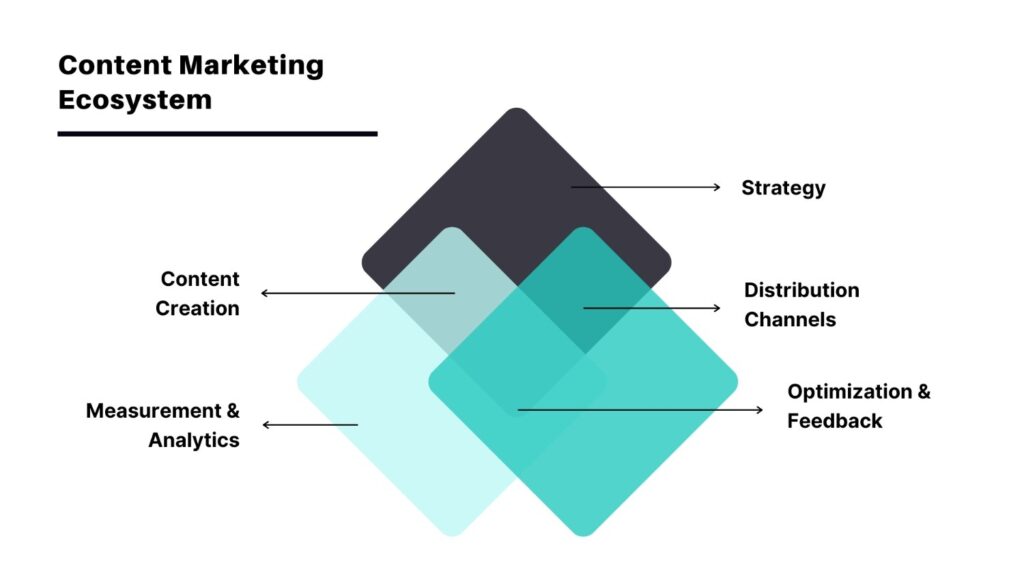Your content marketing ecosystem is more than a bunch of blog posts and social captions!
It is a system where strategy, creativity, and connection work together. However, where does video fit?
Right at the center.
It is a high-impact format that fuels every part of the ecosystem. From explainer videos to scroll-stopping reels, video weaves through every corner of your ecosystem. More insights:
- A content marketing ecosystem connects strategy, creation, and distribution.
- Strategy guides everything with clear goals and audience insights.
- Content creation involves writers, designers, and video as a core format.
- Distribution and feedback keep the system active and adaptive.
- Tools like Notion, HubSpot, and Google Analytics power the process.
Ready to boost your content marketing strategy with video? Our experts at LocalEyes fit videos directly into your content ecosystem and supercharge engagement.
The Core Pillars of a Healthy Content Marketing Ecosystem
There are multiple layers behind a healthy marketing ecosystem. The entire ecosystem keeps content marketing well organized, designed, and distributed. Only then will you achieve your business goals.
So, what are those foundational pillars? Let’s see:

1. Strategic Planning and Audience Understanding
A solid strategic plan is the core of an effective content marketing ecosystem. This is where everything begins. You won’t even come close to success if you don’t have a clear strategy. End of the day, content marketing becomes a guesswork for you.
- Understand your audience deeply
- What audiences need, want, and care about
- Define your unique positioning
- What sets your brand apart
- Set clear, realistic goals
- Your vision can be building brand awareness, generating leads, or improving retention.
Find out Short-Form vs. Long-Form Video: Which Drives Better Results for Your Business? – LocalEyes
2. Content Creation
This is what makes everything worthwhile. In the whole ecosystem, this is what you need the most. Here, all your strategy turns into storytelling. And, you know that story sells!
Key Roles:
- Writers write compelling, clear messages.
- Designers bring ideas to life with visuals.
- Video editors turn your raw footage into something your audience can’t scroll away from.
- Subject Matter Experts (SMEs) give what is missing, like depth, credibility, and unique insight.
Where Video Fits In:
Video isn’t just a nice-to-have. It is a core format in a healthy ecosystem.
Use Cases:
- Explainer videos to simplify complex topics
- Customer testimonials to build trust through authentic voices
- Short-form reels to boost reach and brand recall on social platforms
- Interviews to highlight expertise and thought leadership
- Webinars for education, lead gen, and deep dives
Benefits:
- Delivers higher engagement across nearly every platform
- Repurposing power: one video becomes quotes, clips, blog content, and more
- Improves retention and conversion when embedded in blog posts or emails
Integration with Other Content:
- Supports blog posts and guides as embedded media
- Fuels social media calendars with snackable clips
- Enhances newsletters, landing pages, and product education
- Can even inspire written content based on audience reactions
3. Distribution Channels
No, you aren’t done yet. Creating great content isn’t enough. You need to get it in front of the right people.
- Social media helps spark conversations and expand reach
- SEO makes your content discoverable on Google
- Email keeps your audience engaged directly in their inbox
- Influencers can amplify your message to niche communities
4. Measurement & Analytics
To know what’s working, you have to track it. It shows you what to double down on.
- Point out what your KPIs are
- Take help from Google Analytics, HubSpot, or social insights
- Open a feedback loop to know what real users think about the content
5. Optimization & Feedback
This is how the ecosystem keeps growing stronger.
- Analyze performance and adjust strategy accordingly
- Use feedback from your audience to refine future content
- Test different formats, topics, and CTAs to improve results
The Hidden Roles in the Ecosystem (That No One Talks About!)
Some things often don’t catch marketers’ attention. The concept of “ecosystem” is actually a big area that needs to be covered.
However, marketers tend to overlook a few roles that they are supposed to do.
Let’s find out what those are.

1. Content Operations & Project Managers
They’re the glue of the content team. Their job is to ensure the chaos stays under control.
They will do:
- Keep projects on schedule and within scope
- Manage workflows, briefs, and deadlines
- Coordinate between creators, designers, and editors
- Ensure version control, consistency, and delivery
2. SEO Strategists vs Content Creators
No, not rivalry. It is a partnership, even though their roles are different. However, you need both of them to scale.
- SEO comes with the strategy. Their work is around keywords, structure, and discoverability.
- Content creators pen down a storyline. They do the storytelling and bring clarity.
Relatable Reads: Video SEO In 2025: 10 Proven Tips To Improve Your Website’s Rankings
3. Sales and Customer Support
These frontline teams talk to real people daily. They know what matters.
- Sales hears objections and questions that content answers.
- Customer support faces recurring issues and product confusion.
- Feeding their insights into content creation
- They see the crack between what the brand says and what customers ask.
4. Leadership Alignment
Leaders don’t have to be on the content creation plan. Their job is to see if everything is aligned with them. That’s all.
- Give strategic direction and business goals.
- Approve budgets, tools, and team structure.
- Set the tone for brand voice and company values
- Champion content marketing as a long-term investment
Ecosystem vs Funnel vs Flywheel: What’s the Difference?
It might all sound similar, but it’s not. Sure, there are content marketing funnels and flywheels, but each one does its own thing.
1. The Funnel
The funnel is the classic model. It is useful in many ways.
- Visualizes the customer journey from awareness to purchase
- Take the potential customer through the entire sales process
- Focuses on stages: Top (awareness), Middle (consideration), Bottom (conversion)
- When a person enters the funnel, the goal is to make a customer.
📌 Limitation: Once someone “converts,” the funnel ends. It doesn’t show what happens next.
Check out Video Marketing Funnel: What It Is & How It Works (2025) – LocalEyes
2. The Flywheel
The flywheel builds on the funnel but adds momentum.
- Focuses on continuous growth through customer experience
- Stages are: Attract, Engage, and Delight
- Shows how satisfied customers drive growth as promoters.
- It’s circular, not linear
📌 Limitation: It focuses on motion and momentum, not the larger environment.
3. The Ecosystem
This is the bigger picture. The system that makes everything sustainable.
- Looks at how people, processes, platforms, and teams interact
- Includes content ops, feedback loops, leadership, brand voice, SEO, and distribution channels.
- It highlights how all parts support each other, beyond just conversion or delight.
- It supports funnel and flywheel thinking by aligning the flywheel and funnel.
📌 Strength: Prevents silos, breakdowns, and shortsightedness.
Let’s talk about your content marketing ecosystem today!
How to Build Your Content Marketing Ecosystem?
It’s time to build your content marketing ecosystem. Here, you’ll find everything you need to follow step by step.
1. Start with the Foundation
Before you create a single blog post or video, start with the groundwork.
- Define your audience
- Clarify your positioning
- Set SMART goals
- Create a simple content mission statement
2. Map Out the Key Roles
Your ecosystem needs the right people, or at least clarity on who’s doing what.
- Writers create content in the brand voice
- Designers / Editors for making content visually appealing
- SEO Strategists ensure content is discoverable
- Content Ops / Project Managers keep the wheels turning
- Analytics & Growth track performance and guide improvements
- Sales / Support brings real customer insights into content
3. Choose the Right Platforms
Select tools that align with your workflow and goals. Don’t overcomplicate.
| Roles | Platforms | For |
| Project & Content Planning | NotionTrelloAirtable | Calendars, briefs, and collaboration |
| Distribution & Publishing | BufferHootsuiteMailchimpWordPress | Scheduling and sharing |
| SEO & Optimization | AhrefsSEMrushClearscope | Performance and keyword strategy |
| Analytics & Feedback Loops | Google AnalyticsHubSpotHotjar | Tracking and insights |
Relatable Reads: Video Seeding: 10 Powerful Distribution Techniques You Should Try
4. Identify the Gaps (People, Platforms, or Purpose)
Seeing the cracks in the ecosystem? Start looking for these common gaps:
- People: Are roles overloaded or unclear?
- Platforms: Are your tools outdated or disconnected?
- Purpose: Is content created without the “why” or “who”?
5. Connect the System
Now build the structure that keeps everything running in sync.
- Use Notion or Trello to manage the content pipeline
- Use Airtable for custom dashboards, status tracking, or content databases
- Use HubSpot or Mailchimp for email automation and nurturing
- Use Google Analytics to monitor traffic, conversions, and engagement
- Set monthly feedback check-ins with sales, support, and leadership
6. Optimize, Don’t Just Operate
Ecosystems aren’t “set it and forget it.” They grow with your business.
- Review performance quarterly
- Run content audits to update or retire old assets
- Revisit goals and audience shifts regularly
- Encourage cross-functional feedback to evolve the system
Common Ecosystem Breakdowns (And How to Fix Them)
Let’s say the content ecosystem is not working or something has gone wrong. What are you going to do? We’ll highlight some problems you might be dealing with and show you how to sort them out.
1. Siloed Teams
When teams don’t talk to each other, the entire system suffers.
Symptoms:
- The content team is unaware of customer feedback from sales or support.
- SEO and brand teams have conflicting goals
- Leadership does not need to be part of execution to make decisions.
Fix:
- Hold monthly or biweekly cross-team meetings for better understanding
- Share your content plans with other team members in Notion
- Make place for sales, support, product planning team, and content ideation.
- Encourage shared KPIs so everyone’s pulling in the same direction.
2. No Content Feedback Loops
Publishing without learning is like talking without listening.
Symptoms:
- You don’t know which content is actually working
- The same types of content are produced over and over, regardless of results
- Customer feedback, sales, and performance data are rarely considered
Fix:
- Implement monthly performance reviews
- Collect qualitative feedback from support or user surveys
- Take help from Google Analytics to see the conversion and engagement
- Make data part of your content creation process
3. Publishing Without a Distribution Strategy
Even great content won’t perform if no one sees it.
Symptoms:
- Blog posts go live but get little traction
- Social posts feel random or last-minute
- Email newsletters aren’t aligned with your content calendar
Fix:
- Build a distribution checklist for every piece of content
- Align content with platform-specific formats
- Repurpose content into multiple formats
- Create a distribution calendar with your editorial calendar.
4. Wrong Tools for the Wrong Stage
Using the wrong tools can slow you down instead of supporting you.
Symptoms:
- You’re overwhelmed with tools no one uses or understands
- Early-stage teams are paying for enterprise platforms they do not need.
- Data is scattered across tools and is hard to analyze
Fix:
- See what tools are being used and what is going wrong
- You can go for tools like Notion and Trello for the first batch of the team
- Give scaling teams the all-in-one tools like HubSpot
- Standardize workflows for tool support.
Frequently Asked Questions: Video in Content Marketing Ecosystem
What is a content marketing ecosystem?
A content marketing ecosystem is a connected system of people, processes, platforms, and content working together.
What are the 5 C’s of content marketing?
The 5 C’s are: Clarity, Consistency, Credibility, Creativity, and Customer-focused.
What is the marketing ecosystem?
The marketing ecosystem is the broader environment of tools, teams, channels, and strategies.
What is the content for the ecosystem?
Content for the ecosystem includes all formats: blogs, videos, emails, social posts, and more.

Executive Producer at LocalEyes Video Production | Emmy Award Winning Producer



